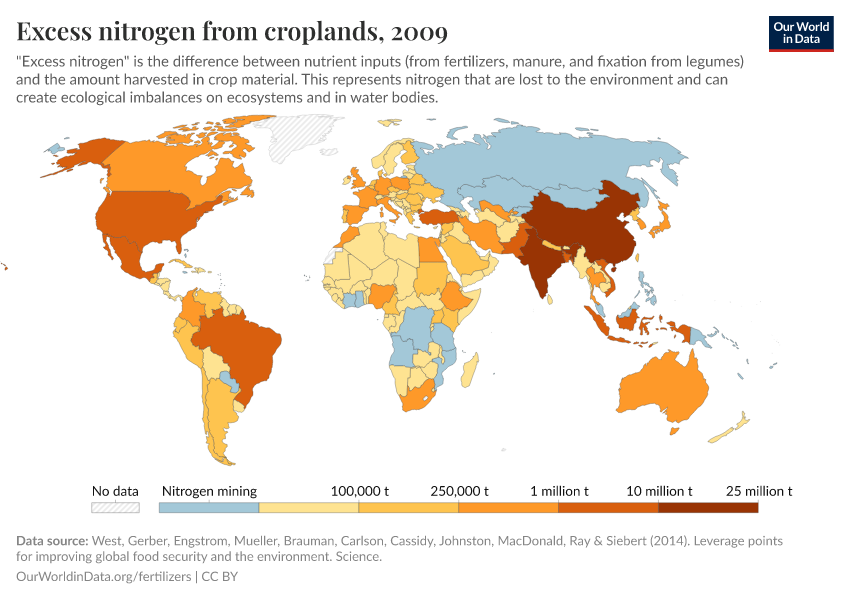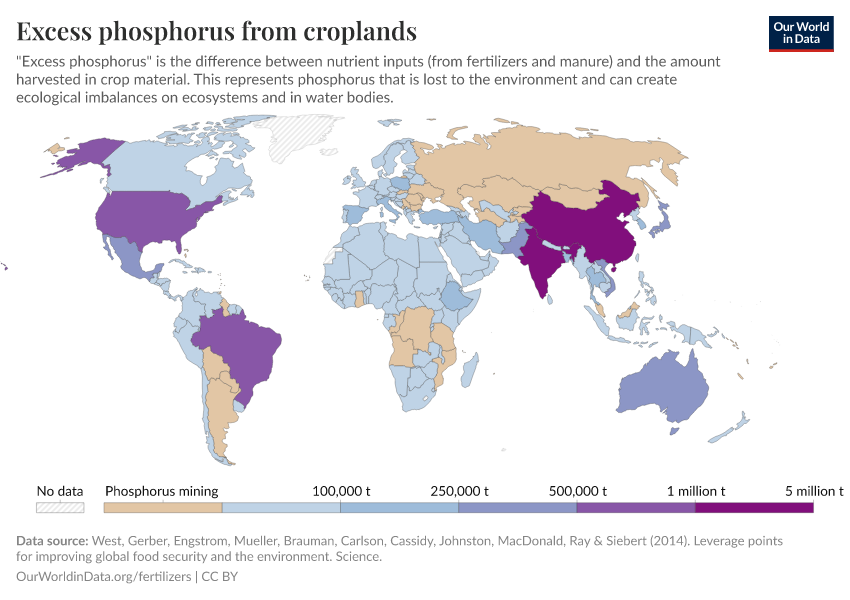Excess fertilizer use: which countries cause environmental damage by overapplying fertilizers?
Nutrients are essential for crop growth. But when they're overapplied they become a pollutant.
Summary
Fertilizers have transformed the way the world produces food. They have not only brought large benefits for food security, but they also bring environmental benefits through higher yields (and therefore less land use). But, there can be a downside. When we overapply fertilizers – no matter whether they are natural ones like manure or synthetic fertilizers – excess nutrients are washed off and pollute the natural environment.
Nitrogen and phosphorus are the two main fertilizers that farmers add to their fields. Research presented here shows that nearly two-thirds of the nitrogen we use on our crops becomes a pollutant; more than half of applied phosphorus does. There are large differences in how much pollution countries generate through their agricultural practices. Some produce almost none; others produce hundreds of kilograms per hectare of cropland.
Fertilizers have brought the world massive socioeconomic and developmental benefits. They improve crop yields. This has two advantages. First, we can grow more food. Second, we need to use less land for farming, and therefore destroy fewer ecosystems in the process.
But alongside these environmental benefits, there are some downsides. Not all of the nutrients we apply – in fact, as we explore in a related article, less than half of it globally – is used by the crops.1 The rest runs off our farms into the natural environment: if this happens then it pollutes rivers and lakes; causes imbalances in ecosystems and affects biodiversity.
What is the global extent of fertilizer pollution? Which countries cause the most avoidable pollution?
We can measure this using a metric called “excess nutrients”. This metric shows us how much of the nutrients that farmers apply as fertilizer runs off into the natural environment.
In a paper published in Science, Paul West and his colleagues mapped the nutrient balance for nitrogen and phosphorus – the main nutrients we add to our crops – across the world.2 They quantified the amount of nutrient inputs – this can come in the form of synthetic fertilizers, organic additions such as manure, or even biological fixation of nitrogen from legume plants – and the output, which is the amount of nitrogen or phosphorus that is stored in the crops that we harvest.
The difference between inputs and outputs is “excess”: nutrients that are not used by the crops and instead run-off into the natural environment.
Nearly two-thirds of applied nitrogen is not used by our crops
This research finds that globally farmers apply around 115 million tonnes of nitrogen to our crops every year. Only around 35% of this is used by them, meaning 75 million tonnes of nitrogen runs off into our rivers, lakes and natural environments. This is our “excess nitrogen”. It is quite staggering that almost two-thirds of our applied nitrogen becomes an environmental pollutant.
Which countries create the most nitrogen pollution? The maps below show this from two perspectives.
First, as the excess nitrogen per hectare of cropland. Here we see large differences across the world.
Some countries actually produce ‘negative’ nitrogen pollution, they are shown in blue. This is known as nitrogen mining. This happens when countries undersupply nitrogen fertilizers, but continue to try to grow more and more crops. Crops then have to take nitrogen from the soil. Over time this depletes soils of their nutrients which will be bad for the productivity of these soils and crop production in the long-run.
Other countries massively oversupply nitrogen. These are the countries shown in the darker shades of red here. Countries such as Kuwait, Singapore, South Korea, Egypt, New Zealand, China, and Taiwan create more than 100 kilograms of excess nitrogen per hectare. For every hectare of cropland, they produce hundreds of kilograms of pollution.
The other map shows total nitrogen pollution – the sum of pollution generated in each country, rather than per hectare. This is given as each country’s share of the global total.
China generates the most nitrogen pollution, accounting for one-third of the global total. India produces almost one-fifth (18%); the USA produces 11%; followed by Pakistan and Brazil.
It’s not that surprising that the countries with the largest populations (and some of the largest land masses) create the most pollution. But as I explore in a related article, there are lots of opportunities to reduce fertilizer use (and pollution) without sacrificing crop yields.
Both of these metrics – the amount of excess nitrogen per hectare, and the total excess are important. Excess per hectare informs us of where nutrients are being used inefficiently; if this number is high then farmers are overapplying fertilizers and organic nutrients. But total excess is also important because it informs us of where we’re likely to have hotspots of water and ecosystem pollution. We need to be aware of regions with lots of farmland and excess nutrients because surrounding rivers and lakes are at high risk of becoming polluted.
More than half of applied phosphorus is lost to the environment
The other main nutrient we add to our crops via fertilizers is phosphorus.
Globally farmers apply around 25 million tonnes every year. 14 million tonnes are not used by the crops and become a pollutant. That means that more than half goes to waste.
Just as we looked at with nitrogen, we can see which countries produce the most excess phosphorus; first per hectare, then as the total per year. This is shown in the maps below.
Most of the countries that overapply nitrogen are the same ones that also overapply phosphorus. Singapore, New Zealand, Japan, South Korea, and Belgium, are all near the top of the list.
Unsurprisingly, given their population size and land mass, the largest polluters are similar to nitrogen. China tops the list, producing one-third of the world’s excess phosphorus. This is followed by India at one-fifth; Brazil at 7%; United States at 6%; and Pakistan at 3%.
Some countries could use more fertilizer; some could use less
Many countries – particularly poorer countries across Sub-Saharan Africa – do not use enough fertilizer. Their crop yields suffer as a result. This is bad for farmers; food security; and the environment because it means they need to use more land for agriculture. As I covered in my recent article, Sub-Saharan Africa is projected to be the hotspot of habitat loss in the coming decades as a result of expanding croplands. Thousands of mammals, birds and amphibian species are at risk. The good news is that if we can improve crop yields, we can prevent almost all of this. Fertilizers will play an important role in achieving this.
At the other end of the spectrum, some countries use too much. They could use much less – and produce much less pollution – without it affecting crop yields. Getting this balance right would bring a range of socioeconomic and environmental benefits. In a related article we look at this trade-off in more detail, and explore the possible solutions for reducing nutrient pollution.
Acknowledgments
Many thanks to Paul West and Luis Lassaletta for the provision of data and feedback on this work.
Explore more of our work at Our World in Data
Endnotes
Lassaletta, L., Billen, G., Grizzetti, B., Anglade, J., & Garnier, J. (2014). 50 year trends in nitrogen use efficiency of world cropping systems: the relationship between yield and nitrogen input to cropland. Environmental Research Letters, 9(10), 105011.
West, P. C., Gerber, J. S., Engstrom, P. M., Mueller, N. D., Brauman, K. A., Carlson, K. M., ... & Siebert, S. (2014). Leverage points for improving global food security and the environment. Science, 345(6194), 325-328.
Cite this work
Our articles and data visualizations rely on work from many different people and organizations. When citing this article, please also cite the underlying data sources. This article can be cited as:
Hannah Ritchie (2021) - “Excess fertilizer use: which countries cause environmental damage by overapplying fertilizers?” Published online at OurWorldinData.org. Retrieved from: 'https://archive.ourworldindata.org/20251125-173858/excess-fertilizer.html' [Online Resource] (archived on November 25, 2025).BibTeX citation
@article{owid-excess-fertilizer,
author = {Hannah Ritchie},
title = {Excess fertilizer use: which countries cause environmental damage by overapplying fertilizers?},
journal = {Our World in Data},
year = {2021},
note = {https://archive.ourworldindata.org/20251125-173858/excess-fertilizer.html}
}Reuse this work freely
All visualizations, data, and code produced by Our World in Data are completely open access under the Creative Commons BY license. You have the permission to use, distribute, and reproduce these in any medium, provided the source and authors are credited.
The data produced by third parties and made available by Our World in Data is subject to the license terms from the original third-party authors. We will always indicate the original source of the data in our documentation, so you should always check the license of any such third-party data before use and redistribution.
All of our charts can be embedded in any site.






